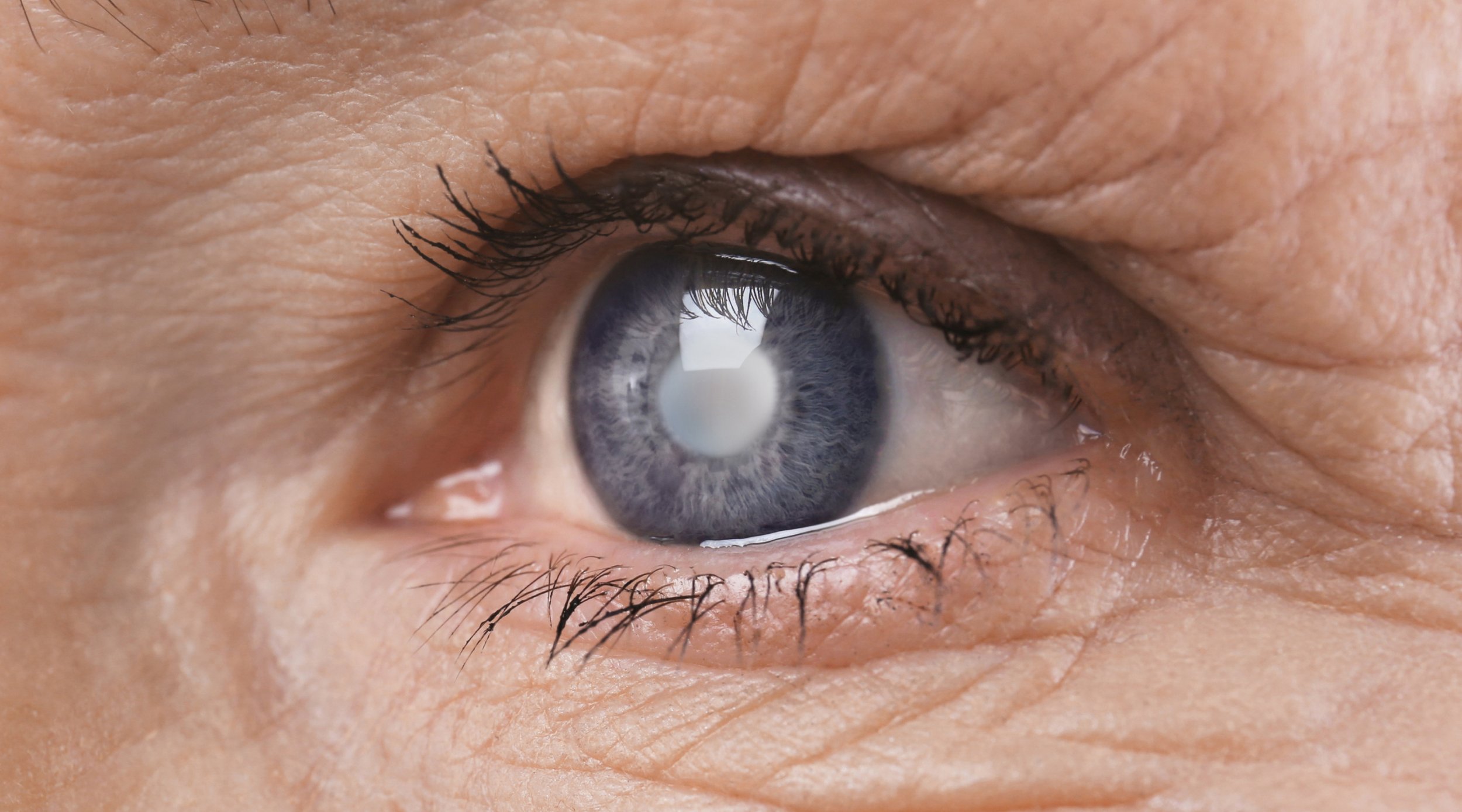CATARACTS
The cataract is the intraocular lens which each person has since birth. The lens eventually becomes opaque, thus causing vision loss. This loss of vision can affect a person's quality of life (their ability to read articles, watch TV, difficulty driving or even recognizing faces, etc).

CAUSES OF CATARACTS
The exact cause of cataract formation is unknown. Cataracts cannot be prevented, but people can take certain steps to slow their progression. For example, the patient may stop smoking and wear sunglasses or hats that block ultraviolet light rays.
Once the cataract affects the person's vision and quality of life, there are no drops, medications, glasses, or exercises that can reverse the process. The only way to restore vision is through surgery. More than 3 million cataract surgeries are done each year in the United States.
RISK FACTORS
01
AGE-RELATED CATARACTS
Aging is the most important risk factor for developing cataracts. More than half of Americans aged 65 and older will have them.
02
SECONDARY CATARACTS
Cataracts most commonly develop in people suffering from diabetes, hypertension, or obesity. Also, in people with a history of using tobacco, alcohol or medications that contain steroids. Having suffered, from a previous trauma or eye surgery predisposes to cataract formation.
TYPES OF CATARACTS
-
A nuclear cataract is the most common type of cataract, beginning with a gradual hardening and yellowing of the central zone of the lens also known as the nucleus. Over time, this hardening and yellowing will expand to the other layers of the lens.
As this type of cataract progresses, it changes the eye’s ability to focus and close-up vision (for reading or other types of close work) may temporarily improve. This symptom is referred to as second sight, but the vision improvement it produces is not permanent.
-
A cortical cataract forms in the shell layer of the lens known as the cortex and gradually extends its “spokes” from the outside of the lens to the center. These fissures can cause the light that enters the eye to scatter, creating problems with blurred vision, glare, contrast and depth perception. People with diabetes are at risk for developing cortical cataracts.
-
Primarily affecting one’s reading and night vision, this type of cataract begins as a small opaque or cloudy area on the posterior (back surface) of the lens. It is called subcapsular because it forms beneath the lens capsule which is a small sac or membrane that encloses the lens and holds it in place.
Subcapsular cataracts can interfere with reading and create halo effects and glare around lights. People who use steroids or have diabetes, extreme nearsightedness, and/or retinitis pigmentosa may develop this type of cataract.
SYMPTOMS
Blurred vision and seeing opaque colors.
Light sensitivity.
Difficulty driving at night or on sunny days.
Frequent changes in the prescription of your glasses.
Noticing halos or light streaks around a light source.
Needing more light to read, recognize faces, or while you are doing a hobby.
Normal Vision
Yellowed Vision
Distorted Vision
Blurry Vision
DIAGNOSIS
Dr. Horta-Santini diagnoses cataracts at the time of your eye exam. The exam will consist of dilating your pupils and examining your lens. In addition, together with his team, they will evaluate their visual acuity and how light affects their vision. You will then get tests with the most advanced technology to obtain accurate measurements to help us select the most suitable intraocular lens implant for your cataract surgery.
TREATMENTS
INTRAOCULAR LENSES
An intraocular lens is implanted in the eye during cataract surgery. These are made of materials that are flexible, malleable, and smaller than 1/3 of a penny. Intraocular lenses have progressed over time. These can improve vision and even decrease dependence on glasses greatly.
Your intraocular lens will have the right power to give you the best vision possible. The lens prescription will be determined using a machine that measures the curvature of the cornea and the length of the eye. Horta-Santini Eye Care has the IOL master 700 from Zeiss, one of the best and latest equipment worldwide for this purpose.
In addition, Horta-Santini Eye Care offers the patient the most comprehensive inventory of FDA-approved intraocular lenses and will work with you to select them.
CATALYS FEMTOSECOND LASER SYSTEM
The Catalys system can measure and identify the size and shape of the cataract, allowing us to make the necessary incisions and remove it without the use of blades.
In addition, the Catalys system gives the patient the opportunity to correct astigmatism in order to improve their visual acuity. Astigmatism distorts or blurs both far and near vision. People who suffer from astigmatism have the shape of their cornea in the form of a football instead of a sphere.
Dr Horta-Santini and his team will tell you if you qualify for the use of the Catalys system. The use of the Catalys laser system is not covered by health insurance companies.
TYPES OF INTRAOCULAR LENSES
-
These are the most common type of lenses and they have been used for several decades. The monofocal lens provides you with the best possible vision for a specific distance - seeing from afar, intermediate or near. Most people choose to have intraocular lenses to see from afar. These people end up using glasses for their activities that require close vision. On the other hand, there are people who choose to have near vision and need glasses to see from afar.
Health insurance companies usually cover the cost of this type of intraocular lens.
-
This is a type of lens that in addition to being a monofocal one, gives the patient astigmatism correction. Astigmatism distorts or blurs vision both far and near. People who suffer from astigmatism have the shape of their cornea in the form of a football instead of a sphere. People with astigmatism need more correction than a monofocal lens can provide. Patients who receive a toric lens are usually very satisfied with their selection. This type of lens is also implanted using the Catalys laser system.
There are other ways to correct astigmatism besides toric lenses. Dr. Horta-Santini and his team will let you know which one you qualify for and suits you. Health insurance companies does not cover the cost of toric intraocular lenses or other forms of astigmatism correction.
-
These are the most modern lenses used in cataract surgery. They have the ability to reduce and eliminate the use of glasses or contact lenses. Multifocal lenses have rings or shapes which alter the trajectory of the light rays as they enter the eye. These make it possible for the patient to clearly see objects that are far, near or intermediate distance. There is a process of adaptation in the person's brain in order to achieve the best possible vision. The ability to read and do other tasks varies from person to person.
The technology in recent years has improved greatly and has made it possible for patients to achieve independence from their glasses. More and more Horta-Santini Eye Care patients have chosen this alternative and are very happy with their results. This type of intraocular lens also comes in toric format and is implanted using the Catalys laser system. These intraocular lenses are not covered by health insurance companies. Talk to Dr. Horta-Santini and his team about these lenses and they will let you know if you qualify for them.
SURGERY
PREPARING FOR SURGERY
Anxiety is normal during the preoperative process of cataract surgery and we are here to answer any questions you may have leading up to surgery.
It is recommended that you come accompanied during your visit and in the case you are unable to be accompanied by another individual they can join you through a video call during your appointment.
Horta-Santini Eye Care is committed to providing you with a cataract surgical and recovery experience with excellence. We understand that it is an honor that you have trusted us with your eye health.
POST SURGERY
-
DescriptionYou will be taken from the operating room to the recovery room. There you will be for about 30 minutes as the effect of the anesthesia wears off. In addition, you will be provided with a snack. You must have a companion, so that you can return home with greater safety and comfort. If you are tired, rest. You will receive a call from Horta-Santini Eye Care to monitor their condition.
A patch will be placed over your operated eye. You will be given instructions on how you should use your patch. It is usually used on the first day of your surgery and every time you sleep or take a nap for a week.
While there are patients who report clear vision within hours of their surgery, there are others who do not. Not all patients and not all eyes are the same. There are some that take longer to recover – a week or two. text goes here
-
The day after your surgery you will return to Horta-Santini Eye Care to monitor your recovery. You will be prescribed several drops, which you will have to use according to the indicated time. In addition, you will be given instructions informing you of the activities you can do or will have to avoid during the postoperative period. It is of the utmost importance that you follow the instructions for your speedy recovery and thus obtain better results.
-
During this period your vision may continue to be blurred. Your eye is recovering and adjusting to look through the new intraocular lens. There are patients who report episodes in which they see curved or distorted lines instead of seeing them straight. It is normal if you have tearing, eye discomfort, or itching in your operated eye. These symptoms will fade over time. It is very important that you do not squeeze your eye.
-
During this time your visual acuity will improve. You will have appointments at Horta-Santini Eye Care to monitor your recovery. Vision should stabilize in about 8-10 weeks. During this time, the cataract from the other eye may also be operated if necessary. Many people need glasses after cataract surgery. Dr. Horta-Santini and his team will let you know the right time to get them. It is important to know that you will need dark glasses during your recovery to protect you from light rays.








